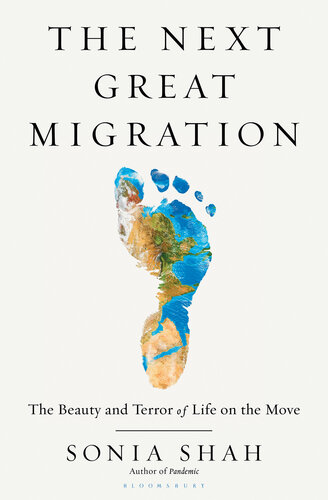
The Next Great Migration
The Beauty and Terror of Life on the Move
- اطلاعات
- نقد و بررسی
- دیدگاه کاربران
نقد و بررسی

April 1, 2020
Following the inception of a sedentary world philosophy that arose in the 18th century, Shah's book tracks how this worldview served to inform future movements from eugenics to anti-immigration policies to conservationism. However, Shah shows that, owing to recent scientific findings and advances in technology, this worldview is increasingly being called into question. Rather, it is becoming clearer that migration and movement are vastly more important, all-encompassing, and central to the lives of all living beings on Earth than previously known. The conclusions and assumptions that this change of focus presents may serve to redefine many types of current movements as well as historical and current events. Meticulously researched, yet highly readable, this work presents a nuanced counterargument to the idea of a static world where each being belongs to a certain place. Instead, using examples from insects to plants to humans, migration is considered a phenomenon that has been and will continue to be practiced by all earthly beings VERDICT. An interesting read that deals with a topic that is current and important to all. It will present a thoughtful challenge to many readers.--Laura Hiatt, Fort Collins, CO
Copyright 2020 Library Journal, LLC Used with permission.

April 15, 2020
Science journalist Shah looks at the biology and human ecology of migration, a topic overladen these days with all sorts of political shadings. The child of Indian immigrants, Shah--author of the excellent and ever more timely book Pandemic (2016)--returns with an incisive examination of migration, which she considers a phenomenon both biological and cultural. Many bird species, for example, travel great distances in annual migrations, and a delicate butterfly species with which the author opens her narrative exhibits "a consistent pattern of movement across half of North America." We have been taught to view such movement as potentially perilous: Invading species arrive, we think, and immediately disturb pristine ecosystems. Even Shah admits that "the idea of migration as a disruptive force has fueled my own work as a journalist." Yet nothing could be more natural than animals moving in response to changes in environmental conditions. As the author shows, only a tiny fraction of relocated species displace others, an act that is consistent with Darwinian theories of natural selection. "Condemning newcomers as inevitably disruptive," she writes, pointedly, "blames them for all transgressions committed by 1 percent or less of their members." When it comes to humans, she writes, the topic becomes more fraught. In a time when humans are increasingly on the move, whether because of political or economic displacement or because their homes are becoming uninhabitable thanks to climate change, politicians such as Donald Trump are using the tiny number of problem-makers, real or potential, to keep the vast majority of law-abiding would-be citizens from making their homes in new lands. This ignores millennia of human movement from one place to the next. Even though "over the long history of life on earth, [migration's] benefits have outweighed its costs," nationalists still create xenophobic, incoherent policies, agreeing only that strangers are to be despised. A scientifically sophisticated, well-considered contribution to the literature of movement and environmental change. (b/w maps)
COPYRIGHT(2020) Kirkus Reviews, ALL RIGHTS RESERVED.

Starred review from May 18, 2020
Science journalist Shah (Pandemic: Tracking Contagions from Cholera to Ebola and Beyond) delivers a masterful survey of migration in both nature and humanity, countering some long-held misconceptions. The biggest of these is the notion that “migration is the anomaly” to a settled existence in one place; in fact, Shah conclusively shows, life has always been “on the move,” as demonstrated in recent decades by new technological tools. DNA analyses indicate widespread human migration goes back further than previously thought—for instance, humans first arrived in Tibet 62,000, not 15,000, years ago. Likewise, real-time tracking of animals using GPS has revealed more extensive migration routes than scientists expected—Arctic terns “logged 70,900-kilometer migrations, nearly twice as long as previous estimates.” In addition to the “scale and complexity of both human and wild movements around the planet,” Shah discusses how a faked nature documentary popularized the myth of mass lemming suicides (thus implying the “appropriate conclusion to the migratory act death”), and how early geneticists’ assertion that “people who lived on different continents were biologically foreign to one another” encouraged racism. This is a valuable treatise on how humanity can “reclaim our history of migration” and adopt a more pan-global perspective. Agent: Charlotte Sheedy, Charlotte Sheedy Literary.

Starred review from June 1, 2020
Shah (Pandemic: Tracking Contagions, from Cholera to Ebola and Beyond, 2016) has crafted an illuminating exploration of how the concept of migration for plants, animals, and humans has been politicized and distorted throughout history. Drawing from a wide range of sources, including the migration patterns of butterflies, lemmings, and coral, the writings of national security expert Robert D. Kaplan (who warned of a coming anarchy ), and the conflicting research of taxonomist Carl Linnaeus and naturalist George-Louis Leclerc, Comte de Buffon, Shah provides an enormously readable survey of how migration has been researched, written about, and blatantly misinterpreted by those seeking justification for their often nativist goals. Shah recognizes the world's current battles over migration, including modern stories of perilous journeys and their frequent appropriation, often for nefarious purposes, by powerful interests. Her occasional inclusion of aspects of her own life story serves to lighten the tone, giving it a personal inflection that makes the historical dimension all the more powerful. This work's beguiling synergy of science, history, and contemporary politics is impressive enough, but it is this intuitive author's captivating narration that makes this such a bracingly intelligent and important title.(Reprinted with permission of Booklist, copyright 2020, American Library Association.)




دیدگاه کاربران